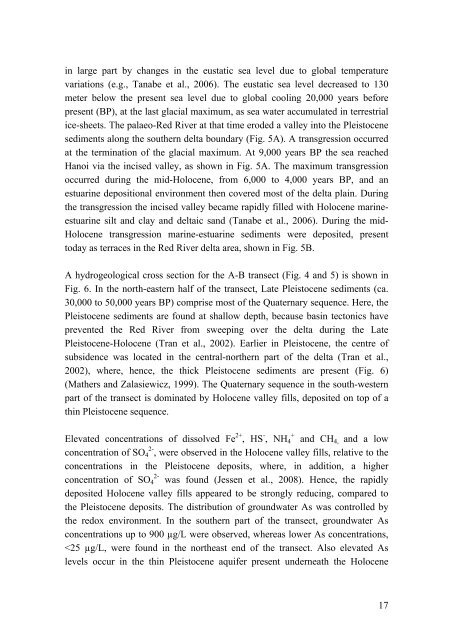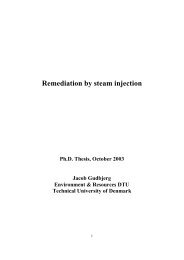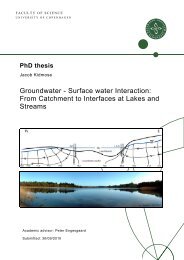Groundwater arsenic in the Red River delta, Vietnam ... - Fiva
Groundwater arsenic in the Red River delta, Vietnam ... - Fiva
Groundwater arsenic in the Red River delta, Vietnam ... - Fiva
You also want an ePaper? Increase the reach of your titles
YUMPU automatically turns print PDFs into web optimized ePapers that Google loves.
<strong>in</strong> large part by changes <strong>in</strong> <strong>the</strong> eustatic sea level due to global temperature<br />
variations (e.g., Tanabe et al., 2006). The eustatic sea level decreased to 130<br />
meter below <strong>the</strong> present sea level due to global cool<strong>in</strong>g 20,000 years before<br />
present (BP), at <strong>the</strong> last glacial maximum, as sea water accumulated <strong>in</strong> terrestrial<br />
ice-sheets. The palaeo-<strong>Red</strong> <strong>River</strong> at that time eroded a valley <strong>in</strong>to <strong>the</strong> Pleistocene<br />
sediments along <strong>the</strong> sou<strong>the</strong>rn <strong>delta</strong> boundary (Fig. 5A). A transgression occurred<br />
at <strong>the</strong> term<strong>in</strong>ation of <strong>the</strong> glacial maximum. At 9,000 years BP <strong>the</strong> sea reached<br />
Hanoi via <strong>the</strong> <strong>in</strong>cised valley, as shown <strong>in</strong> Fig. 5A. The maximum transgression<br />
occurred dur<strong>in</strong>g <strong>the</strong> mid-Holocene, from 6,000 to 4,000 years BP, and an<br />
estuar<strong>in</strong>e depositional environment <strong>the</strong>n covered most of <strong>the</strong> <strong>delta</strong> pla<strong>in</strong>. Dur<strong>in</strong>g<br />
<strong>the</strong> transgression <strong>the</strong> <strong>in</strong>cised valley became rapidly filled with Holocene mar<strong>in</strong>eestuar<strong>in</strong>e<br />
silt and clay and <strong>delta</strong>ic sand (Tanabe et al., 2006). Dur<strong>in</strong>g <strong>the</strong> mid-<br />
Holocene transgression mar<strong>in</strong>e-estuar<strong>in</strong>e sediments were deposited, present<br />
today as terraces <strong>in</strong> <strong>the</strong> <strong>Red</strong> <strong>River</strong> <strong>delta</strong> area, shown <strong>in</strong> Fig. 5B.<br />
A hydrogeological cross section for <strong>the</strong> A-B transect (Fig. 4 and 5) is shown <strong>in</strong><br />
Fig. 6. In <strong>the</strong> north-eastern half of <strong>the</strong> transect, Late Pleistocene sediments (ca.<br />
30,000 to 50,000 years BP) comprise most of <strong>the</strong> Quaternary sequence. Here, <strong>the</strong><br />
Pleistocene sediments are found at shallow depth, because bas<strong>in</strong> tectonics have<br />
prevented <strong>the</strong> <strong>Red</strong> <strong>River</strong> from sweep<strong>in</strong>g over <strong>the</strong> <strong>delta</strong> dur<strong>in</strong>g <strong>the</strong> Late<br />
Pleistocene-Holocene (Tran et al., 2002). Earlier <strong>in</strong> Pleistocene, <strong>the</strong> centre of<br />
subsidence was located <strong>in</strong> <strong>the</strong> central-nor<strong>the</strong>rn part of <strong>the</strong> <strong>delta</strong> (Tran et al.,<br />
2002), where, hence, <strong>the</strong> thick Pleistocene sediments are present (Fig. 6)<br />
(Ma<strong>the</strong>rs and Zalasiewicz, 1999). The Quaternary sequence <strong>in</strong> <strong>the</strong> south-western<br />
part of <strong>the</strong> transect is dom<strong>in</strong>ated by Holocene valley fills, deposited on top of a<br />
th<strong>in</strong> Pleistocene sequence.<br />
Elevated concentrations of dissolved Fe 2+ , HS - , NH4 + and CH4, and a low<br />
concentration of SO4 2- , were observed <strong>in</strong> <strong>the</strong> Holocene valley fills, relative to <strong>the</strong><br />
concentrations <strong>in</strong> <strong>the</strong> Pleistocene deposits, where, <strong>in</strong> addition, a higher<br />
concentration of SO4 2- was found (Jessen et al., 2008). Hence, <strong>the</strong> rapidly<br />
deposited Holocene valley fills appeared to be strongly reduc<strong>in</strong>g, compared to<br />
<strong>the</strong> Pleistocene deposits. The distribution of groundwater As was controlled by<br />
<strong>the</strong> redox environment. In <strong>the</strong> sou<strong>the</strong>rn part of <strong>the</strong> transect, groundwater As<br />
concentrations up to 900 μg/L were observed, whereas lower As concentrations,<br />





